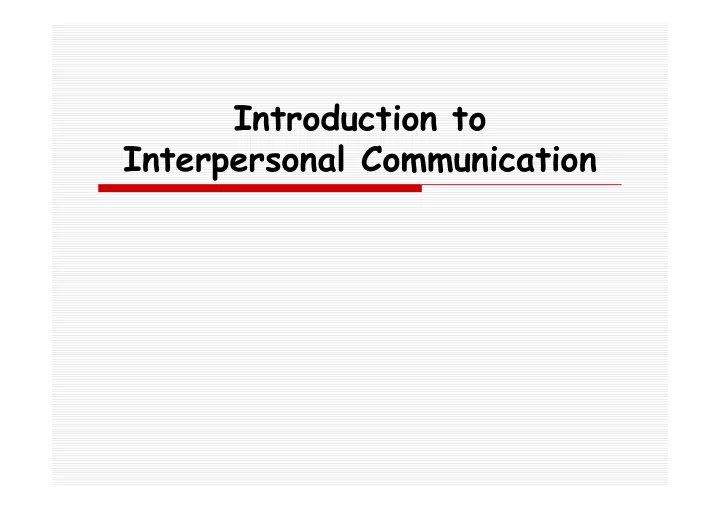

Introduction to Interpersonal Communication
OBJECTIVES FOR CHAPTER ONE � Understand the three main models of human communication (linear, interactional, and transactional models) � Understand the impersonal-interpersonal � Understand the impersonal-interpersonal Communication Continuum � Understand the principles of interpersonal communication � Understand the myths of interpersonal Communication
A Note on Communication Apprehension � I won’t “test” you on the subject of communication apprehension (CA), but I do feel it’s important that you recognize that for some people there is a great that for some people there is a great amount of stress associated with speaking with others. � J. McCroskey’s “Personal Report of Communication Apprehension” (PRCA) is found on page five of your text.
FOUR DIMENSIONS of “CA” � The PRCA measures four specific areas where one might feel CA. � You may be confident in one area but not in another. in another. � The areas are: (1) Group Discussions, (2) Meetings, (3) Interpersonal Conversations, and (4) Public Speaking � Don’t fret, if you experience CA at any level, you can overcome this by studying communication.
Interpersonal Communication is just one type of communication. � INTRAPERSONAL COMMUNICATION � INTERPERSONAL � INTERPERSONAL COMMUNICATION � SMALL GROUP COMMUNICATION � ORGANIZATIONAL COMMUNICATION � MASS COMMUNICATION
Linear Model of Communication � Here’s the whole picture… It is as if communication is something we “do” to someone else. In the next few slides I’ll explain each component.
INFORMATION (SOURCE/SENDER) � The whole communication act starts with the sender who has something to share.
MESSAGE � The sender has a MESSAGE to share—this is some idea, concept, etc. that can be written, oral, or even unspoken (nonverbal).
CHANNEL � The sender will choose a means by which to share their message. This is the CHANNEL. According to M. McLuhan “the means is the message.”
Ending an “Intimate Relationship” � The Channel, which is usually represented by our senses actually says something about the SENDER and the RECEIVER. RECEIVER. � What CHANNELS might be used to say “I don’t want to see you anymore?” � What do the CHANNEL Choices say about the sender and how the sender views the receiver?
TARGET (RECEIVER) � The sender will encode the message (make sense of what they receive) through their very own perspective and here is how we may run into misunderstanding.
NOISE/ENTROPY/INTERFEREN CE � There are four major types of noise. Entropy, noise, interference are all things that impede a message from being understood as meant.
FOUR TYPES OF NOISE � PHYSICAL/EXTERNAL NOISE is noise that occurs outside of the sender and receiver. For example, if a man dressed in an ape costume came running through our ape costume came running through our classroom then this would be an example of classroom then this would be an example of physical noise. � PHISIOLOGICAL NOISE Is noise of a biological nature. For example, if you are not feeling well, you are influenced by this noise.
FOUR TYPES OF NOISE CONTINUED � PSYCHOLOGICAL/INTERNAL NOISE is noise comprised of a communicator’s biases, prejudices, and feelings toward a person and message. I think of them as person and message. I think of them as also thoughts that may be running through your mind. � SEMANTIC NOISE is noise that comes from our attributing different meanings to words.
CONTEXT of Linear Communication � Physical This is where the communication actually transpires (the environment) � Cultural Are the rules, roles, norms, and patterns of a culture. Are the rules, roles, norms, and patterns of a culture. � Social-Emotional Relates to the relationship (and climate) between individuals. � Historical Each message is influenced by those from the past.
Interactional Model of Communication Feedback (internal & external) is added to this model.
Transactional Model of Communication We are communicators coming to a shared meaning
The Nature of Interpersonal Relationships
The Nature of Interpersonal Relationships
The Nature of Interpersonal Relationships
The Nature of Interpersonal Relationships
Defining Interpersonal Communication � Interpersonal Communication Is a Process (Fluid rather than static---it doesn’t happen in a vacuum) happen in a vacuum) � Messages Are Exchanged (Verbal and nonverbal messages are being sent simultaneously between communicators) � Meaning Is Central (Individuals come to their own meanings together)
Principles of Interpersonal Communication � Interpersonal Communication Is Unavoidable � Interpersonal Communication is Irreversible Irreversible � Interpersonal Communication Involves Symbol Exchange � Interpersonal Communication is Rule- Governed � Interpersonal Communication is Learned � Interpersonal Communication Has Both Content and Relationship Information
Myths of Interpersonal Communication � Interpersonal Communication Solves All Problems � Interpersonal Communication Is Always a Good Thing Good Thing � Interpersonal Communication Is Common Sense � Interpersonal Communication Is Synonymous with Interpersonal Relationships � Interpersonal Communication Is Always Face-to-Face
Recommend
More recommend